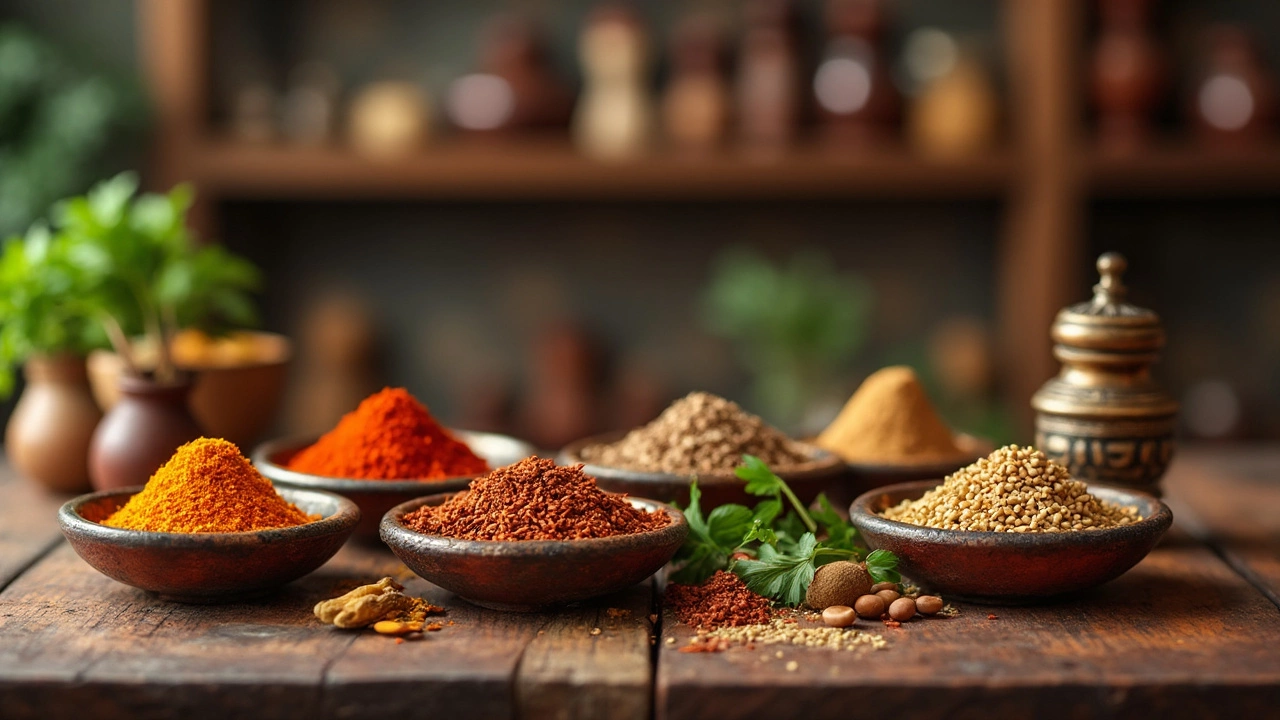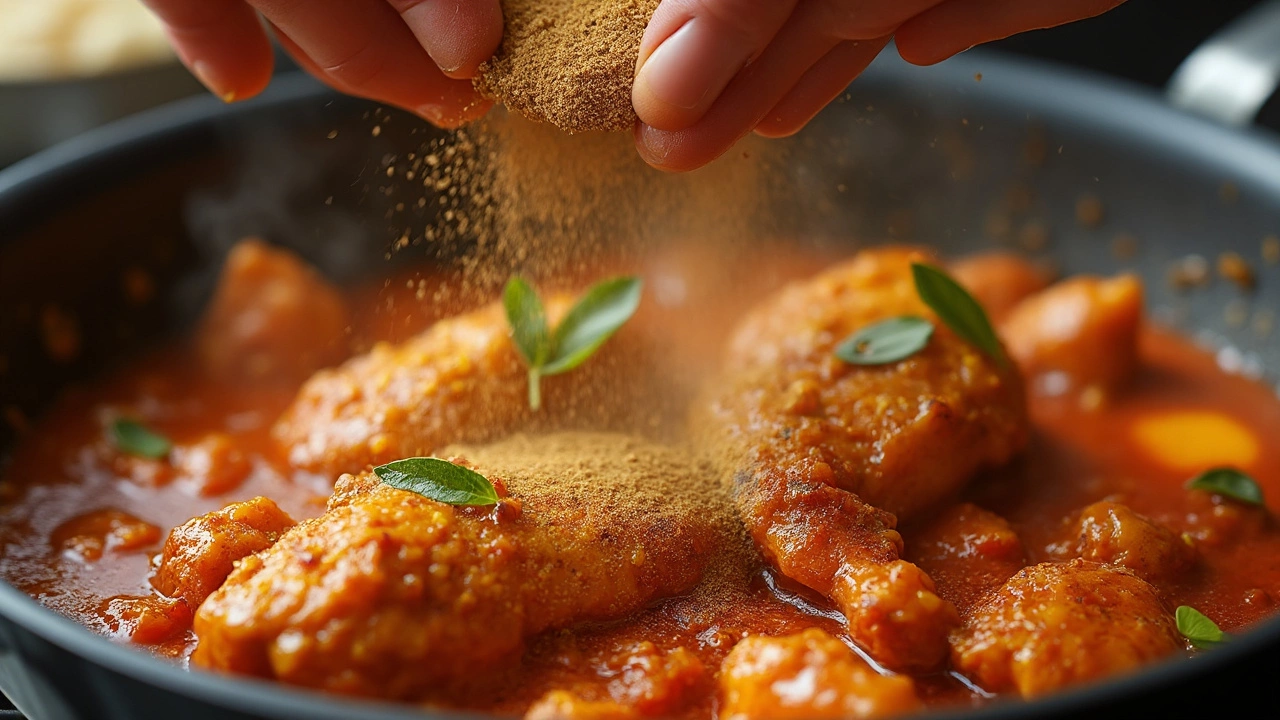What's the Closest Spice to Curry Powder?
 Apr, 4 2025
Apr, 4 2025
Running out of curry powder feels like being stuck in traffic when you're running late—annoying and inevitable at some point. But don't worry! You can still whip up a killer chicken curry with some clever spice swaps. So, what comes close to that magical curry powder? Usually, it's all about the mix. Think along the lines of cumin, coriander, maybe a hint of turmeric or garam masala. Each spice brings something special, and together, they can help you recreate the essence of the missing curry powder.
Now, if you've ever peeked into your spice drawer and felt like you're staring into an abyss, you're not alone. Finding the right substitute doesn't have to be like solving a puzzle. The trick is understanding what makes curry powder so flavorful in the first place. It’s a blend, usually including turmeric, coriander, cumin, and sometimes a whiff of fenugreek or chili powder for a bit of zing. Replicating this mix isn’t as tough as it seems—many of these spices might already be hiding in your kitchen right now!
- Understanding Curry Powder
- Top Spice Alternatives
- Blending Your Own Curry Spice
- Adapting Chicken Curry Recipes
- Tips for Enhanced Flavor
Understanding Curry Powder
So, you've heard of curry powder, but what exactly goes into this golden mix? Well, let's break it down. Curry powder isn't one single spice but a blend of several. Think of it as the symphony of the spice world, with each ingredient playing its part. It usually starts with turmeric, giving it that bright yellow color we all recognize. Then, you've got coriander and cumin, which bring warmth and earthiness. Add a pinch of chili powder if you like some heat, and maybe fenugreek for a touch of bitterness that balances everything out.
The origins of curry powder are pretty interesting too. It's a Western attempt at capturing the essence of Indian curries in a bottle, making it a convenient way for non-Indian cooks to bring some Indian flavor into their kitchens. While traditional Indian cuisines use specific mixes for different dishes, curry powder offers a more general taste profile.
Now, if you've been cooking Indian dishes, you might’ve realized that family recipes often skip the curry powder entirely, using instead a mix of separate spices. Why? Because each region and household in India has its own twist. However, curry powder has made its mark outside of India, especially in recipes like chicken curry, where it's loved for both flavor and simplicity.
Got a recipe that calls for curry powder and want to switch things up? Knowing what makes up this blend helps you adjust flavors to your liking, swapping or adding spices as you see fit. This flexibility lets you personalize dishes without losing that signature curry essence.
Check out this quick list of what's typically in curry powder:
- Turmeric - the yellow hero
- Coriander - earthy and citrusy
- Cumin - warm and nutty
- Chili Powder - for that kick
- Fenugreek - slightly bitter
Top Spice Alternatives
Running out of curry powder doesn't have to be a dealbreaker. I’ve got you covered with some smart spice swaps that can save the day. First thing's first, let's get into some of the core spices that can replicate that warm, aromatic kick.
Cumin is often the unsung hero in the spice game. With its earthy and nutty flavor, it can replace some of the robustness found in curry powder. Just a teaspoon can make a big difference in your curry.
Next up, there's coriander. This one’s got a citrusy, flowery aroma. It's light but knows how to pack a punch—a couple of tablespoons can give your chicken curry that distinct taste you're craving.
If you’re into feeling like a spice wizard, try mixing your own version of curry powder. You'd be surprised how a bit of turmeric for color and slight bitterness, along with garam masala for depth, can make your concoction sing.
Want to go all out? Create your own blend by balancing these spices together:
- 1 tbsp Cumin
- 1 tbsp Coriander
- 1/2 tbsp Turmeric
- 1/2 tbsp Garam Masala
Mingle them to craft a taste that suits your buds. And if you’re feeling adventurous, don’t hesitate to toss in a pinch of pepper flakes for some extra heat.
Each of these alternative spices and combos has something unique to offer, letting you tailor your chicken curry recipe just the way you like it, without stressing over that missing curry powder. So next time you're in a pinch, remember, your spice drawer is like your secret toolkit!

Blending Your Own Curry Spice
So, you want to make your own curry powder magic at home? It's easier than you think. You get to control the flavor, the heat, the whole vibe of your dish. Let's break it down into simple steps.
First, gather the essentials. A typical curry powder mix usually includes a few key players: turmeric, cumin, and coriander. They're like the holy trinity of curry spices. Depending on your taste, you can add a pinch of chili powder for some kick or fenugreek for a hint of bitterness.
Here's a basic mix to get you started:
- 1 tablespoon ground turmeric
- 1 tablespoon ground cumin
- 1 tablespoon ground coriander
- 1 teaspoon chili powder (adjust to taste)
- 1 teaspoon ground fenugreek (optional)
- 1/2 teaspoon black pepper
Mix these spices in a bowl. You can tweak the amounts based on how colorful you want your curry to be or how spicy you like it. Once your blend is ready, store it in an airtight container. It should last you about six months, but if you cook a lot, it might not even last that long!
Now, if you're curious about what makes a good chicken curry recipe pop, you can also add a bit of ground ginger or garlic powder. These won't let the taste fall flat. Trust me, your taste buds will thank you.
If you're a statistic junkie or just love knowing random facts—did you know that roughly 85% of Indian households use homemade spice blends rather than store-bought ones? It’s all about that personal touch.
Blending your own curry spice isn't just about saving the day when you're low on curry powder. It's a way to make every dish truly your own. So, whip up a batch, invite some friends over, and impress them with your very own signature spice mix. You'll never look at pre-made curry powder the same way again.
Adapting Chicken Curry Recipes
Switching up your chicken curry recipe when you're low on curry powder is like jazz improvisation—fun and rewarding if you know your notes. Here’s a simple way to adjust your dish without missing out on the aromatic essence.
Start by assessing the core ingredients in curry powder. Depending on what you're aiming for, you might prioritize a few spices over others. Here's a quick guide:
- Cumin: Brings warmth and a bit of earthiness. Perfect if you like your curry with those rich, deep notes.
- Coriander: Offers a citrusy and slightly nutty flavor. It's light and balances out stronger spices.
- Turmeric: Adds vibrant color and earthy bitterness. Useful for that classic golden hue.
- Garam Masala: A blend on its own, often including spices like cinnamon and cardamom. It's what you grab when you're aiming for complexity.
To adapt your recipe, here’s a quick method:
- Sauté onions, garlic, and ginger in oil as usual. This forms the base.
- Add a teaspoon each of cumin and coriander. Balance with turmeric—a half teaspoon works for most.
- For that extra punch, introduce one or two teaspoons of garam masala towards the end of cooking.
- Let the spices bloom in the oil for a minute or two before tossing in chicken pieces.
- Add tomatoes and simmer until your chicken is tender and the oil separates on top of the curry gravy.
With these tweaks, your chicken will soak up the spices beautifully, bringing that coveted aroma to your kitchen. If you feel adventurous, consider a pinch of fenugreek or a hint of chili powder for finishing touches!

Tips for Enhanced Flavor
Bringing out the best in your chicken curry goes beyond just replacing lost curry powder. There’s a world of flavors waiting to be unlocked with a few smart tips. Let’s explore how you can amp up the taste in ways you might not have thought of before.
First off, get cozy with fresh herbs. Fresh coriander or cilantro can transform the aroma and taste of your curry. It not only livens up the dish but also adds a burst of color. If you love a bit of a kick, fresh chili is your best friend.
Another trick for deepening flavor is to toast whole spices. Before you grind them, put cumin or coriander seeds in a dry pan over a low flame until they're fragrant. This simple step can make a huge difference. A chef once told me, "Toasting is where the magic happens. It's the fastest way to wake up your spices."
"The secret to a great curry isn’t just the spices you use, but how you use them," says Chef Atul Kochhar, a Michelin-starred chef known for his expertise in Indian cuisine.
Don’t underestimate the power of cooking oil. Ghee or coconut oil can give a richer, creamier texture compared to regular oils. And if you want to up your Indian cooking game, a pinch of asafoetida, also known as hing, adds a unique umami that complements the dish beautifully.
Here’s a small tip: balance your flavors. Acidic elements like lemon juice or tamarind can cut through the richness of curry, while a dash of sweetness, maybe from a bit of jaggery, rounds it off perfectly.
- Add fresh elements: Fresh coriander leaves or a slice of lime on the side can enhance flavor and presentation.
- Use quality ingredients: Fresher spices and good quality ingredients can really make a dish pop.
- Experiment with textures: A sprinkle of toasted cashews or almond slivers on top adds crunch and an extra layer of taste.
So the next time you’re whipping up a chicken curry, remember these tips. They can turn your replacement spices into a symphony of flavors that even your grandma would approve of!